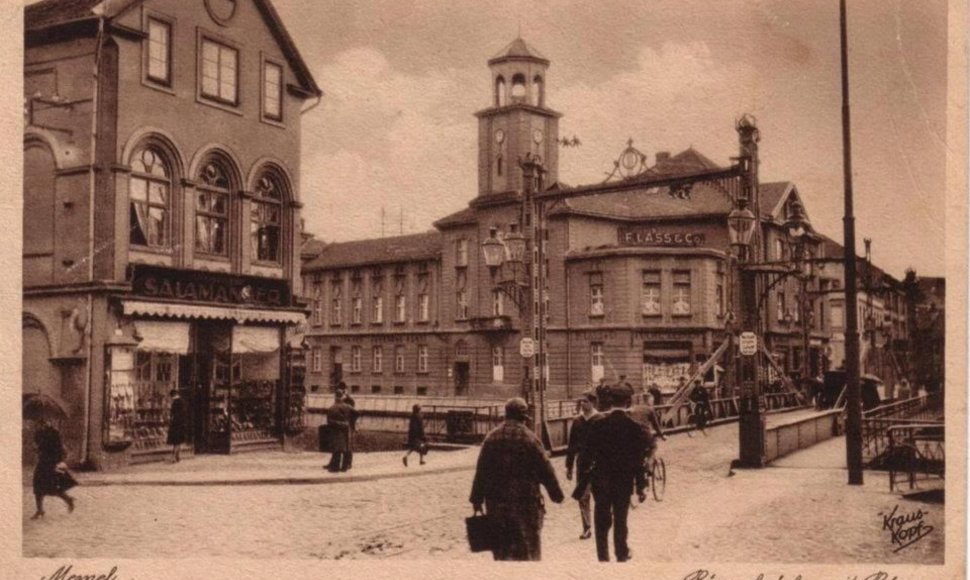For the occasion, Klaipėda has already received a very important document bearing the city seal. The historic act has not been exhibited in Lithuania before.
“The document is significant for two reasons. Firstly, it is dated 5 November 1446 and is the oldest known document bearing the seal of Klaipėda. Secondly, we're celebrating the town's anniversary this year, we've declared 2012 the year of the flag and the coat of arms. So this exhibit is very timely.
“The act has not been exhibited in Lithuania before. Twenty years ago, we weren't even sure if it had survived. Old authors had written that such a document existed, but it was thought to have disappeared. Later historians got hold of it. When I'm asked if that's something other-worldly, I reply that it's not a king's crown with diamonds. It is a text written by the citizens of Klaipėda and the city government many years ago. It is currently held in the archives of the city of Lübeck,” says historian Jonas Genys, director of the Lithuania Minor History Museum.
- Is it possible for Klaipėda to retain the document?
- No, that is not an option. The act was addressed to Lübeck from the citizens of Klaipėda.
- Klaipėda is exceptional among Lithuanian towns in that it knows the exact date of its “birthday.” It was on 1 August that the Grand Master of the Teutonic Knights and the bishop of Curonia confirmed in writing a construction of a castle. But could a city spring up in plain field?
- The site chosen for the city must have been already well known, it was a relatively densely-populated Curonian region. But it doesn't mean there was a settlement already where a castle was to be built. Archaeological excavations reveal that the site was inhabited by Curonians by the time the castle was built. Possibly they even helped build it, were part of the community.
The site chosen for the castle was not very favourable – sandy soil, frequently flooded delta of the river Danė. You could only build a castle here if forced by circumstances. Neighbouring Curonian castles were much better-situated. Settlements of Žardė and Laistai were a big centre – about 7 kilometres from the Castle of Memel.
- What sort of people settled here?
- Initially, knights and monks. Of course, they must have been accompanied by artisans, merchants, people servicing the castle. The problem was that the town, founded in 1252 and granted the Lübeck rights several years later, did not grow very fast. Because of historic circumstances, Klaipėda remained a small town with tiny population up until the 16th century. The reason for this might have been attacks from Samogitians, Sambians, Lithuanians, competition with the ports of Riga and Königsberg.
- The Livonian Order handed over the land to the German Order in Prussia. Was it a sort of renunciation?
- Something must have not worked out. The renunciation, if you will, happened in the first half of the 14th century. The city with its castle became the northern reach of the Order and later part of the Prussian state.
- We see many tragic ruptures in the history of Klaipėda, it changed hands many times. When was, in your opinion, Klaipėda's golden age?
- It is tricky to point out a golden period for Klaipėda. What about other towns? When it comes to Vilnius, one instantly thinks of Baroque. It seems that this was the period when Vilnius was flourishing. But it is ambivalent, since the state as a whole was on the decline. It is a difficult question. Klaipėda probably experienced a rise only in late 19th century.
For a long time, the development of the city as a craft and trade centre was hindered by its status as a fortress. Prussia saw Klaipėda as a fortification, even though there was trade here and shipbuilding. Everything changed after a fire in the 19th century. Paradoxically, the town began to thrive after a disaster. It was rebuilt very quickly, it became architecturally rich, citizens opened a gas factory, installed electricity, built tramlines, paved the streets.
The city became modern and clean. Let's remember the impression of Queen Louise (1776-1810) when she visited it with her suite. She thought the town was dismal, with its dirty unpaved streets. By the second half of the 19th century, everything had changed dramatically.
- The 20th century, on the other hand, seems like a nightmare in Klaipėda history. It changed hands several times. It seemed that even its citizens knew not at times who ruled them.
- The period was complicated throughout Europe. Perhaps a more important year was 1923 when Klaipėda was annexed by Lithuania.
- We've all seen the photo showing Antanas Smetona (Lithuania's inter-war president) waded in the see, as if showing that Lithuania is a marine country. Did Lithuania indeed become a marine country?
- I think we're in the process of becoming a marine country, even though we must decide what we mean by the term. We're usually sceptical, saying that we're still a long way off from being a marine country like Sweden or Norway. The marine pulse is best felt here, by the sea. It is only natural that people in Pasvalys, Biržai, and other Lithuanian towns feel it less. The entire country does not have to walk around wearing sailor shirts.
After 1923, the Lithuanian state directed huge funds to reconstruct the port. With his gesture, Smetona showed the direction that Lithuania had to go, what to do.
- One can still discern contours of the old castle in the centre of Klaipėda. How are reconstruction works moving forward?
- It took time before the reconstruction process got going. This year, we will begin development works.
I believe that the site will be integrated into the fabric of the city very harmoniously and beautifully. By reconstructing it, we will add value to the town, we will put an end to all questions about what to do with tourists who come here on Monday, when all museums are closed. It is important for the citizens of Klaipėda to reclaim signs of the city lost during the course of history.
Klaipėda vs. Memel
The original name of Klaipėda, Memel, originates from the River Nemunas. The city bore the name for almost 700 years. In official documents, Memel appears as late as 20th century.
At the same time, local Samogitians gave their own name to Memel. It is unclear when the name first came to be used. In historic documents, Klaipėda appears in the 15th century. In a 1413 letter, Grand Duke Vytautas, who was conducting negotiations with the Teutonic Order, refers to “castrum Memel alias Klawpedda.”
It is said that the name was inspired by the fact that the city was built in a swampy site – “klampi pėda” or “swampy foot.” Klaipėda came to be used in vernacular even though Memel still remained the official name of the city for a long time.



















